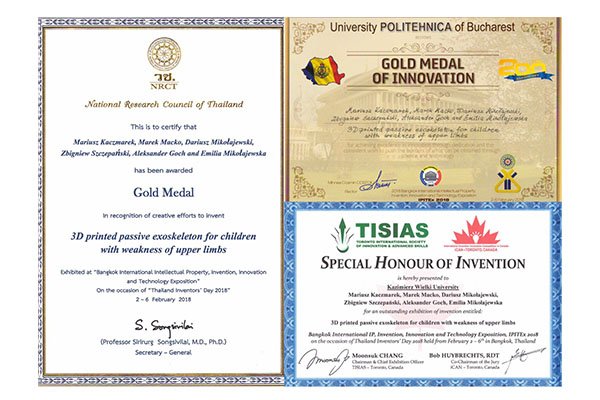Medal-worthy exoskeleton
2018-02-15
Scientists from the Chair of Physiotherapy at Nicoalus Copernicus University’s Collegium Medicum: professor Aleksander Goch, PhD (the Chair’s head) and doctor Emilia Mikołajewska have achieved great success at the Intellectual Property, Invention, Innovation and Technology Exposition” IPITEx 2018 fair in Bangkok (Thailand).
The representatives of Nicolaus Copernicus University have received the gold medal and two special awards for making a 3D-printed passive exoskeleton meant to support children’s weakened upper limbs, created under the project “3D printed passive exoskeleton for children with weakness in upper limbs”.
The team responsible for the invention includes: professor Mariusz Kaczmarek, PhD, Eng, professor Marek Macko, PhD, doctor Dariusz Mikołajewski, Eng., and Zbigniew Szczepański, MA, from the Institute of Mechanics and Applied Informatics of Kazimierz Wielki University in Bydgoszcz, and professor Aleksander Goch, PhD, and doctor Emilia Mikołajewska from the Chair of Physiotherapy at Toruń’s Nicoalus Copernicus University’s Ludwik Rydygier’s Collegium Medicum in Bydgoszcz.
The cooperation of specialists in medicine and engineers has resulted in creating an exoskeleton which is meant to support atonic muscles of children, with the possibility to extend its use upon adults. It is possible due to the use of 3D printing, which means that each exoskeleton is made individually for each user, according to the measurements obtained through 3D scanning of their upper body and limbs. It can be said that it is tailor-made, as an element of patient-tailored therapy.
For people with muscle atony even the simplest daily activities, such as washing, dressing up or eating, are a difficult, if not impossible, challenge. An exoskeleton, due to supporting their movements, is meant to facilitate those activities, thus improving their chances of achieving independence and self-reliance. A great advantage of an exoskeleton is that an external skeleton is placed on a human body without interfering into its structures. The way it is constructed makes is a passive device- aimed at supporting the activity of weakened muscles without using an engine or a controlling computer. It allows for a reduction of the exoskeleton’s weight to a minimum, in order not to provide additional burden to the atonic upper limbs.
The IPTEX 2018 fair in Bangkok, during which delegations from several dozens of countries- with the team of scientists including professor A. Goch, PhD, and doctor E. Mikołajewska as one of them- have presented hundreds of innovative solutions and inventions, took place on 2-6 February 2018. The event was held by National Research Council of Thailand (NRCT). The awards for the project entitled “3D-printed passive exoskeleton for children with weakness in upper limbs” were awarded by the leaders of two delegations: the Canadian and the Romanian one.

